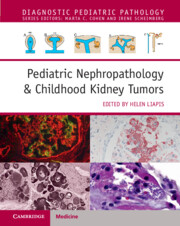Book contents
- Pediatric Nephropathology & Childhood Kidney Tumors
- Diagnostic Pediatric Pathology
- Pediatric Nephropathology & Childhood Kidney Tumors
- Copyright page
- Dedication
- Contents
- Contributors
- Preface
- Section 1 Normal and Abnormal Human Kidney Development
- Section 2 Glomerular Diseases
- Chapter 3 Idiopathic and Hereditary Proteinuric Glomerular Diseases
- Chapter 4 Haematuric Glomerular Diseases (Collagenopathies)
- Chapter 5 Immune Complex Mediated Glomerular Diseases
- Chapter 6 Inherited Metabolic Diseases Affecting the Kidney
- Chapter 7 Glomerular Diseases with Fibrillary Deposits
- Chapter 8 Mitochondrial Diseases in the Pediatric Kidney
- Section 3 Tubulointerstitial Diseases
- Section 4 Vascular Diseases
- Section 5 Infectious Diseases
- Section 6 Cystic Diseases
- Section 7 Solid Tumors of the Kidney
- Section 8 Transplant Pathology of the Kidney
- Index
- References
Chapter 7 - Glomerular Diseases with Fibrillary Deposits
from Section 2 - Glomerular Diseases
Published online by Cambridge University Press: 10 August 2023
- Pediatric Nephropathology & Childhood Kidney Tumors
- Diagnostic Pediatric Pathology
- Pediatric Nephropathology & Childhood Kidney Tumors
- Copyright page
- Dedication
- Contents
- Contributors
- Preface
- Section 1 Normal and Abnormal Human Kidney Development
- Section 2 Glomerular Diseases
- Chapter 3 Idiopathic and Hereditary Proteinuric Glomerular Diseases
- Chapter 4 Haematuric Glomerular Diseases (Collagenopathies)
- Chapter 5 Immune Complex Mediated Glomerular Diseases
- Chapter 6 Inherited Metabolic Diseases Affecting the Kidney
- Chapter 7 Glomerular Diseases with Fibrillary Deposits
- Chapter 8 Mitochondrial Diseases in the Pediatric Kidney
- Section 3 Tubulointerstitial Diseases
- Section 4 Vascular Diseases
- Section 5 Infectious Diseases
- Section 6 Cystic Diseases
- Section 7 Solid Tumors of the Kidney
- Section 8 Transplant Pathology of the Kidney
- Index
- References
Summary
Glomerular diseases with organized fibrillary deposits are rare entities and more so in children. They can be simply categorized as amyloid or non-amyloid diseases using the Congo red stain. All amyloidogenic proteins as a rule stain positive with Congo red. Non-amyloid diseases can be further classified into organized fibrils with immunoglobulin components (fibrillary glomerulonephritis [FGN] and immunotactoid glomerulopathy [ITG]), and those without immunoglobulin components (fibronectin glomerulopathy and collagenofibrotic glomerulopathy among others). These deposits may have overlapping features that pose a multitude of challenges in making a correct diagnosis. Routine histological features may aid in diagnosis, but electron microscopy and special stains pertaining to each disease are frequently required. Renal prognosis in these conditions remains poor and treatment options are limited.
- Type
- Chapter
- Information
- Pediatric Nephropathology & Childhood Kidney Tumors , pp. 159 - 170Publisher: Cambridge University PressPrint publication year: 2023



